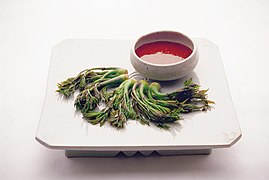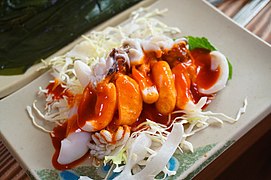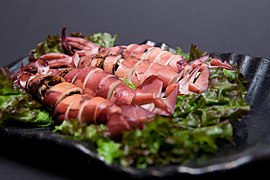 Muneo-sukhoe (blanched octopus) Muneo-sukhoe (blanched octopus) | |
| Type | Hoe |
|---|---|
| Place of origin | Korea |
| Associated cuisine | Korean cuisine |
| Korean name | |
| Hangul | 숙회 |
|---|---|
| Hanja | 熟鱠 |
| Revised Romanization | sukhoe |
| McCune–Reischauer | sukhoe |
| IPA | [su.kʰwe̞] |
Sukhoe (Korean: 숙회) is a variety of hoe dishes consisting of blanched vegetables, seafoods, or offals. Sukhoe is usually dipped in chojang, the mixture made of gochujang and vinegar.
History
A number of sukhoe varieties are listed in a 17th-century cookbook, Jubangmun.
Varieties
Further information: Ganghoe § Varieties- Cheonggak-hoe (청각회) – Blanched green sea fingers are chopped finely, and served with chojang (dipping sauce made with gochujang and vinegar).
- Dureup-hoe (두릅회) – Blanched dureup (angelica-tree shoots) are served with chojang.
- Eochae (어채) or saengseon-sukhoe (생선숙회) – Fresh fish, boiled beef lung, sea cucumber, abalone are sliced, mixed with silpa (thread scallions), Indian chrysanthemum leaves, pyogo and seogi mushrooms, and coated with starch slurry, blanched, and served in sesame milk.
- Gaji-hoe (가지회) – Aubergines are blanched in salt water, sliced thinly, and served with mustard sauce.
- Minari-hoe (미나리회) – Blanched or raw minari (Oenanthe javanica) is served with chojang.
- Muneo-sukhoe (문어숙회) – Fresh giant octopus is skinned, blanched, and served with chojang.
- Sunchae-hoe (순채회) – Young leaves of brasenia is blanched, soaked in cold water, strained, and served with chojang.
Gallery
-
 Dureup-hoe (blanched angelica-tree shoots) served with chojang
Dureup-hoe (blanched angelica-tree shoots) served with chojang
-
 Eumnamu-sun-hoe (blanched castor aralia shoots)
Eumnamu-sun-hoe (blanched castor aralia shoots)
-
 Hanchi-sukhoe (blanched mitre squid)
Hanchi-sukhoe (blanched mitre squid)
-
 Horaegi-sukhoe (blanched loliolus squid)
Horaegi-sukhoe (blanched loliolus squid)
-
 Muneo-sukhoe (blanched giant octopus)
Muneo-sukhoe (blanched giant octopus)
-
 Ojingeo-sukhoe (blanched flying squid)
Ojingeo-sukhoe (blanched flying squid)
See also
References
- Lee, Sung Woo; Kim, Kyung Jin; Lee, Hyo Gee (1983). "A Bibliographical Study of Korea-Food Terms". Korean Journal of Food & Nutrition (in Korean). 12 (2): 150–175. Retrieved 21 September 2018.
- "Sukhoe" 숙회. Standard Korean Language Dictionary (in Korean). National Institute of Korean Language. Retrieved 20 September 2018.
- Kim, Eun-Mi; Yu, Ahe-Ryung (2012). "A Literature Review on the Culinary Characteristics of Zubangmoon". Korean Journal of Food and Cookery Science (in Korean). 28 (6): 675–693. doi:10.9724/kfcs.2012.28.6.675.
- "Cheonggak-hoe" 청각회. Standard Korean Language Dictionary (in Korean). National Institute of Korean Language. Retrieved 21 September 2018.
- "Dureup-hoe" 두릅회. Standard Korean Language Dictionary (in Korean). National Institute of Korean Language. Retrieved 21 September 2018.
- "Eochae" 어채. Standard Korean Language Dictionary (in Korean). National Institute of Korean Language. Retrieved 20 September 2018.
- "Gaji-hoe" 가지회. Standard Korean Language Dictionary (in Korean). National Institute of Korean Language. Retrieved 21 September 2018.
- "Minari-hoe" 미나리회. Standard Korean Language Dictionary (in Korean). National Institute of Korean Language. Retrieved 21 September 2018.
- "Muneo-sukhoe" 문어숙회. Standard Korean Language Dictionary (in Korean). National Institute of Korean Language. Retrieved 20 September 2018.
- "Sunchae-hoe" 순채회. Standard Korean Language Dictionary (in Korean). National Institute of Korean Language. Retrieved 21 September 2018.
This Korean cuisine–related article is a stub. You can help Misplaced Pages by expanding it. |